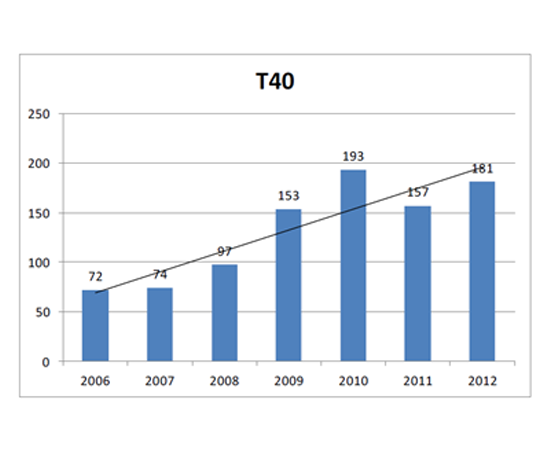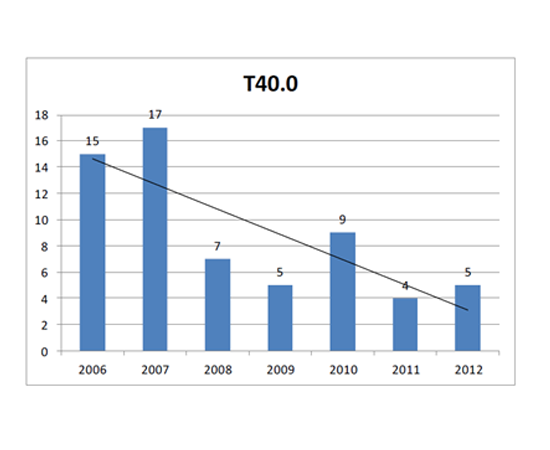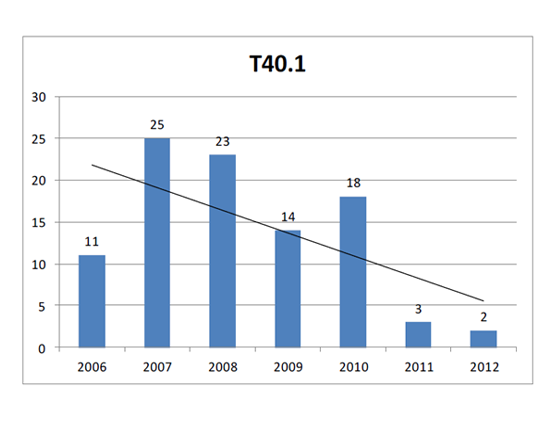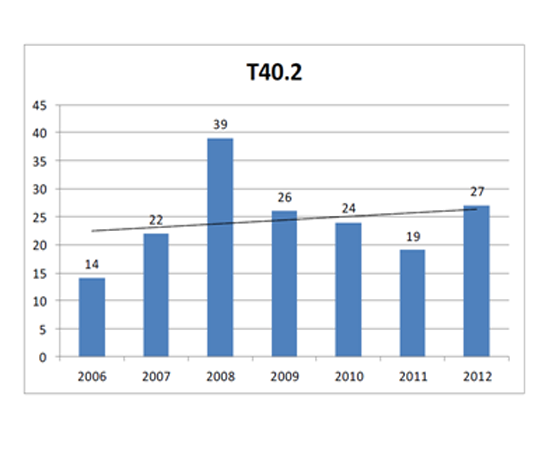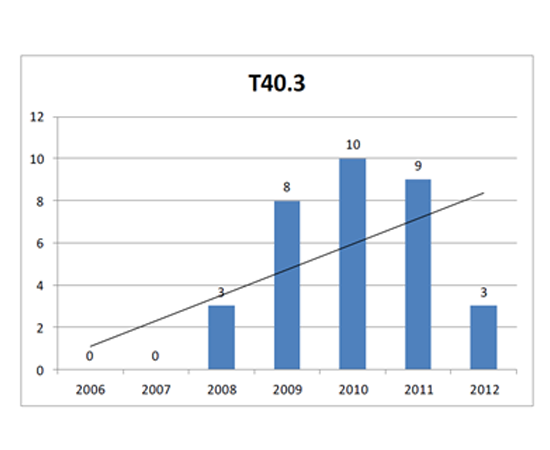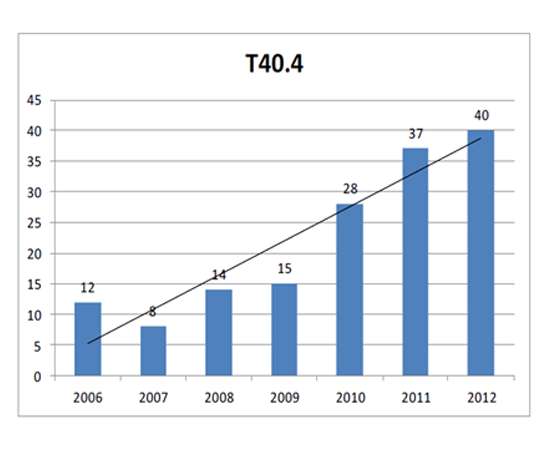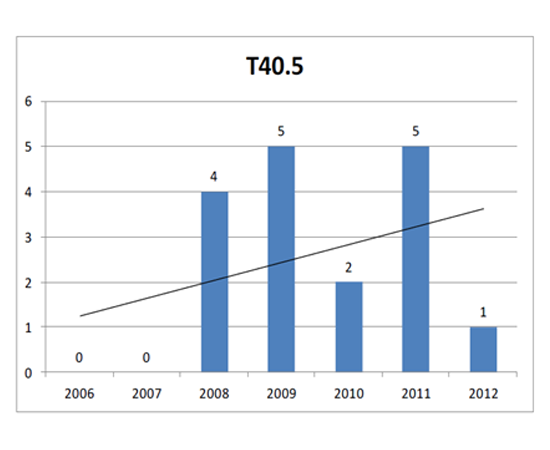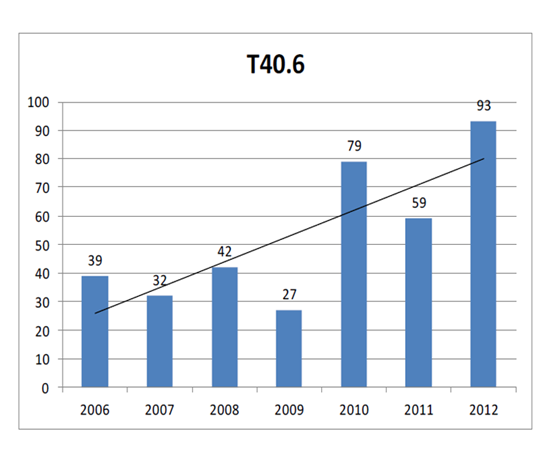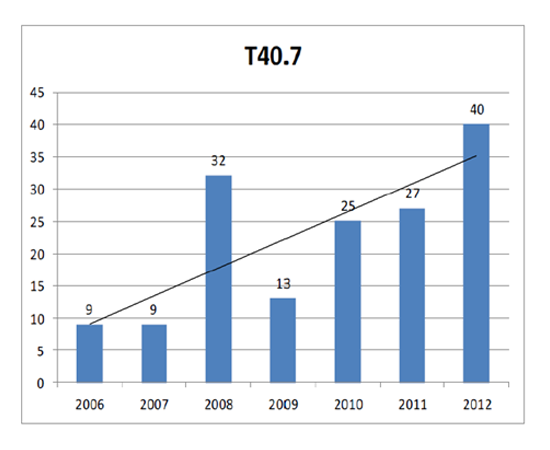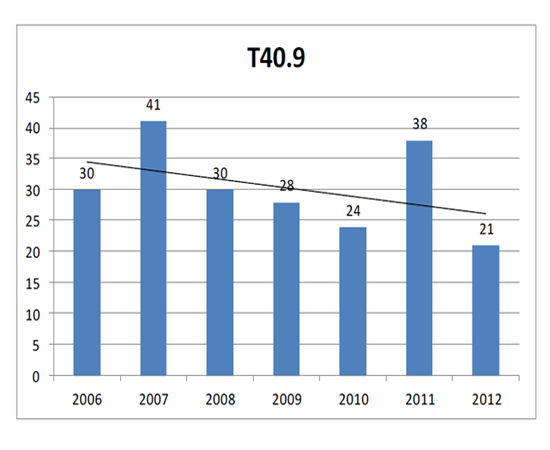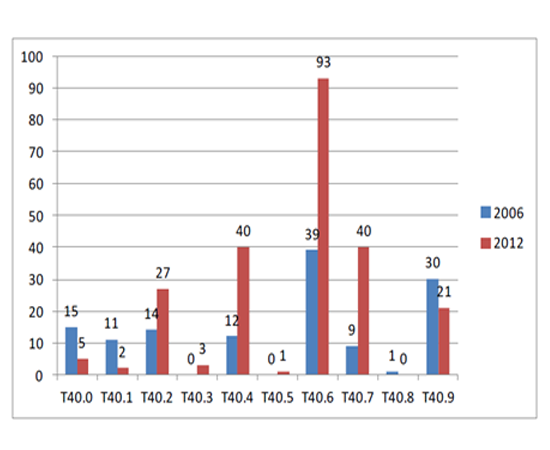Information
Journal Policies
Important to Forensic Medicine Trends in Hospital Admissions Due to Intoxications with Narcotic Substances (T40 ICD-10) in the Lower Silesia Region of Poland in the Years 2006-2012
Robert Suslo1,3*, Piotr Hanczyc2, Jaroslaw Drobnik1
2.Lower Silesia Gynecology Center, Wroclaw, Poland.
3.University Clinical Hospital, Public Health Department, Poland.
Copyright : © 2016 Muhammad I. This is an open access article distributed under the Creative Commons Attribution License, which permits unrestricted use, distribution, and reproduction in any medium, provided the original work is properly cited.
Abstract
Being aware of the importance of statistical structure of poisonings for directing of toxicological analyses both in clinical and especially forensic medicine, the study was aimed at finding current incidence of narcotic substances intoxications in the Lower Silesia region of Poland as well as determining any long time trends. Data on causes of hospital admissions because of poisoning by narcotics and psychodysleptics (T40 according to ICD-10) in the years 2006-2012, made available due to courtesy of the public healthcare insurance provider Narodowy Fundusz Zdrowia in Lower Silesia region of Poland (NFZ), were analyzed. The study revealed that in the years 2001-2012 the causes of intoxications with narcotic substances in the Lower Silesia region of Poland have been changing in a consistent way. In the years 2006-2012 the total amount of hospital admissions caused by narcotic substances intoxications increased significantly. The amount of intoxications with opioids, and especially opiates, dropped - but they have been practically fully replaced by methadone poisonings. The incidence of cannabis and cannabinoids abuse cases increased, as well as the incidence of serious intoxications with unspecified and/or synthetic narcotic substances. Cocaine and lysergide intoxications resulting in the hospitalizations were casuistic. The increased share of intoxications with untypical or synthetic narcotic substances among the acute poisonings cases in the Lower Silesia region of Poland makes establishing the proper diagnosis difficult or, in some cases, even renders it practically impossible at all.
Keywords: Narcotic Substances; Toxicology; Public Health; Forensic Medicine; Drug Abuse Statistics.
Abbreviations: GC/MS - Gas Chromatography/Mass Spectroscopy, LC/MS - Liquid Chromatography/Mass Spectroscopy, DDA - Data-Dependent Acquisition, NFZ - Narodowy Fundusz Zdrowia in Lower Silesia region of Poland, District Division in Wroclaw.
1.Introduction
Toxicological analysis is very important in every day forensic medicine activities, especially in determining the cause of the death. Narcotic substances used for medical purposes or, more often, abused invariably tend to cause finally severe complications needing hospital admissions [1]. It is important for any physician to keep in mind that intoxication with opioids confirmed by objective tests does not automatically eliminate the possibility of coexistence of other causes of the deteriorating status of the patient, in the first place neurologic disorders - accepting the intoxication as the absolute explanation for the clinical status can easily lead to diagnostic medical error [2]. Unfortunately, there is no universal, applicable to any person, linear dependence between the levels of psychoactive substances in the blood and the intensity of intoxication symptoms [3]. Opioids are primarily involved in managing of broad spectrum of physiological processes, especially pain perception [4]. Abusing narcotic substances is a category of broadly defined self-injury - and human sciences are associating self-injuries with lacks in social competence, disturbed emotional intelligence and poor coping with stress [5], which become more common in the society, especially in adolescents currently more and more often lacking exposure to proper parental attitudes [6]. Blind screening for unknown drugs, drugs of abuse and other toxic substances requires the use of modern sophisticated laboratory methods, like Gas Chromatography/Mass Spectroscopy (GC/MS) or Liquid Chromatography/Mass Spectroscopy (LC/MS), combined with Data-Dependent Acquisition control (DDA) for the purposes library comparison, that is not always available, especially in smaller laboratories [7]. The possibilities to identify toxic substances even in trace amounts and highly degraded samples are impressing, but practically they can be applied only in cases when at least the substance class is known in advance [8]. The even bigger problems arise in case of “new designer drugs” as their interaction with physiological functions of organism and chemical composition is often initially unknown and undergoes frequent modifications [9]. Knowing the most common intoxications in the local population can help to limit the scope of the initial screening applied in case of most of the hospital intoxication-related admissions and forensic cause of death investigations – thus allowing keeping its costs at relatively low levels without impairing the efficacy at the same time [10]. The medical information, also on intoxications, derived from different institutions collecting statistical data can vary significantly [11]. Some of the narcotic substances, especially opiates and opioids, are widely used in the medical care - especially in treatment of patients in oncologic palliative care and non-oncologic chronic pain management [12]. Most of them require high, and rising with time, doses of the narcotic substances which leads to the risk of respiratory arrest, especially in some specific groups of heightened-risk patients which often cannot be determined in advance [1]. Some of those drugs cause disturbances in respiratory center function and others can lead to secondary respiratory arrest, typically due to blocking the airways: because of vomiting or assuming not physiological position of the body preventing proper ventilation [13]. In forensic medicine the use and abuse of narcotic substances is more and more often considered in the context of possible euthanasia [14].
2. Materials and Methods
Data on causes of hospital admissions because of poisoning by narcotics and psychodysleptics (T40 according to ICD-10) in the years 2006-2012, made available due to courtesy of the public healthcare insurance provider Narodowy Fundusz Zdrowia in Lower Silesia region of Poland (NFZ), were analyzed. The aim of the study was to find out the current incidence and trends in the most common and important intoxications in the analyzed period of time to facilitate the process of toxicology diagnostics for both clinical and forensic medicine purposes.
3. Results and Discussion
The current study is the expression of the authors long lasting interest in the topic of intoxications in the Lower Silesia region of Poland. The authors previously examined the respective trends in the years 2001-2006 based on the results of toxicology tests performed on samples collected during forensic autopsies at Forensic Medicine Department of Wroclaw Medical University that performed significant amount of Lower Silesia forensic toxicology analyses at the time. According to the results of the previous study summed up in Figure 1, in the years 2001-2006 the total amount of forensic toxicology analyses oriented on narcotic substances detection increased by 72%. There was significant change in the intoxications structure as over the 6 years time the percentage of cases in which opiates and opioids intoxications were diagnosed dropped by 55,9% of its initial share among positive results of tests, while at the same time the amount of amphetamine group substances intoxications raised by 61,5% of its initial share. The cocaine intoxications were represented by very rare cases and their incidence dropped during in the years 2001-2006 [10].
Over the years 2006-2012 the population of the Lower Silesia region of Poland, did not change significantly in amount or age structure, although some effects of population ageing were observed [15]. In the year 2014 in the Lower Silesia was inhabited by 2,9 million people, 52% of them females [16].
The current study allowed for gathering and analyzing data on the absolute amount of hospital admissions yearly due to “poisoning by narcotics and psychodysleptics” (T40 according to ICD-10) not specified further as it is shown in Figure 2. The raising trend in the narcotic substances intoxications showed previously for the years 2001-2006 on the basis of forensic autopsy data, was confirmed and continued in the next 7 years by the hospital admissions data analyzed in the current study; the amount of those increased 2,5 times. There were registered several cases of intoxications with mixed narcotic substances.
The drop in popularity of opiates and opioids visible in the years 2001-2006 was also continued in the years 2006-2012 - while opium and heroin intoxications cases (T40.0 and T40.1 according to ICD-10, respectively) became casuistic, other opioids (T40.2 according to ICD-10) did not lose their popularity, as it is shown in Figures 3-5.
The phenomenon of rapid raising incidence of methadone intoxications (T40.3 according to ICD-10) in the Lower Silesia region the years 2008-2011, as it is shown in Figure 6, can be explained by introduction of drug addicts controlled treatment programs - some of the substance made available to the patients in the ramifications of the therapy was probably sold or exchanged by them with other drug addicted persons thus allowing the intoxications due to unlimited use.
In the years 2006-2012 there was a rapid increase in hospital admissions due to intoxications by synthetic narcotics other than methadone (T40.4 according to ICD-10), as it is shown in Figure 7. The use of lysergide (T40.8 according to ICD-10) was proven among hospital patients in casuistic cases only.
The use of cocaine in Lower Silesia region of Poland in the years 2006-2012 remained marginal, but the admissions caused by cocaine intoxication (T40.5 according to ICD-10) showed a slightly increasing trend, according to the data shown in Figure 8.
The use and abuse of unspecified narcotics other than opiates, opioids and cocaine (T40.6 according to ICD-10) more than doubled over the analyzed 7 years in the Lower Silesia region, as it is shown in Figure 9.
During the 7 years long analyzed period the amount of hospital admissions due to cannabis and cannabinoids (T40.7 according to ICD-10) use in the Lower Silesia region quadrupled, as it is shown in Figure 10.
The amount of psychodysleptics abuse(T40.9 according to ICD-10) ending up with hospitalizations dropped slightly in the years 2006-2012 in the Lower Silesia region, as it is shown in Figure 11.
The Figure 12 shows the causes of the narcotic substances associated admissions to the Lower Silesia region hospitals in the beginning and in the end of the examined period of time. However, it is worth noticing that those figures do not fully mirror the trends - as in the year 2012 the methadone and cocaine intoxications were underrepresented in the available data in comparison to the previous years. It draws the attention that in the year 2012 the intoxications with unspecified and/or synthetic narcotic substances of different chemical groups are present in the vast majority of reported test results in cases of narcotic abuse related hospitalizations.
4. Conclusion
Between years 2001 and 2012 the causes of intoxications with narcotic substances in the Lower Silesia region of Poland have been changing in a consistent way. In the years 2006-2012 the total amount of hospital admissions caused by narcotic substances intoxications increased significantly.
In the years 2006-2012 among causes of intoxications needing admission to hospital in the Lower Silesia region of Poland the marginalization of opioids, and especially opiates, progressed - but they have been practically fully replaced by methadone, most probably leaking into black market from therapeutic replacement programs for drug addicts.
The incidence of cannabis and cannabinoids serious abuse has increased in the Lower Silesia Region of Poland in the years 2001-2006 and continued to increase over the analyzed period of next 7 years; in contrast to that, cocaine and lysergide intoxications resulting in the hospitalizations were casuistic.
The incidence of intoxications with unspecified and/or synthetic narcotic substances belonging to different chemical groups, as well as their share in the total amount of diagnosed intoxications needing admission to a hospital, increased in the Lower Silesia region of Poland in the years 2006- 2012.
Being aware of the up to date statistics of various narcotic substances intoxications incidence allows both clinically active physicians and forensic medicine specialists to adjust the scope of primary tests applied, limiting the average costs of establishing the diagnosis as well as shortening the time needed for that. The increased share of intoxications with untypical or synthetic narcotic substances among the acute poisonings cases in the Lower Silesia region of Poland makes establishing the proper diagnosis difficult or, in some cases, even renders it practically impossible at all.
5.Acknowledgments
The authors thank the NFZ for allowing them the access to the publication-relevant data.
References
- Suslo R, Trnka J, Siewiera J, Drobnik J.: Ondine's curse genetic and iatrogenic central hypoventilation as diagnostic options in forensic medicine, Adv.Exp. Med.Biol. 2015 Vol.861: Neuroscience and respiration. Vol.14: Respiratory health; PP 65-73.
- Klys M, Kowalski P.: Diagnostic medical error as an overinterpretation of toxicology screening combined with inadequate clinical assessment; Arch.Med.Sad.Krym., 2011, LXI: PP 377-382
- Korczynska M, Kulikowska J, Celinski J, Rojek S, Uttecht-Pudelko A.: State under the influence of drugs or psychotropic agents - a comparison of toxicological and medical examinations in materials of the Department of Forensic Medicine and Toxicology, Silesian University of Medicine, Katowice; Arch.Med.Sad.Krym., 2011, LXI: PP 35-42
- Paulev PE, Thorboll J, Nielsen U, Kruse P, Jordal R, Bach F, Fenger M, Pokorski M.: Opioid involvement in the perception of pain due to endurance exercise in trained man, Japanese Journal of Physiology, Vol. 39(1989) No.1 PP 67-74
- Kulikowska A, Pokorski M.: Self-injuries in adolescents: social competence, emotional intelligence and stigmatization; Journal of Physiology and Pharmacology 2008, 59, Suppl 6, PP 383-392
- Drozdz E, Pokorski M.: Parental attitudes and social competence in adolescents; Journal of Physiology and Pharmacology 2007, 58, Suppl 5, PP 175-184
- Imran M., Screening for unknown compounds in forensic toxicology, ARC Journal of Forensic Science, Volume 1, Issue 1, 2016, PP 10-12
- Szpot P, Buszewicz G.: Determination of ramipril in human plasma and study of its fragmentation by UPLC-Q-TOF-MS with positive electrospray ionization; Acta Pharm. 65 (2015) PP 159-169
- Maciow-Głab M, Rojek S, Kula K, Klys M.: “New designer drugs” in aspects of forensic toxicology; Arch Med Sad Kryminol 2014; 64 (1): PP 20–33
- Suslo R, Trnka J, Drela E, Drobnik J, Mastalerz-Migas A.: Medical examination profiling in cases of narcotic substances intoxication in medical practitioners’ everyday practice; Family Medicine & Primary Care Review 2008, 10, 3: PP 690–692
- Drobnik J.: Ocena wybranych parametrów świadczeń zdrowotnych i systemu sprawozdawczości w ochronie zdrowia w zakresie analizy trendów epidemiologicznych i potrzeb zdrowotnych oraz ich wpływ na wybrane elementy polityki zdrowotnej na podstawie danych z województwa dolnośląskiego, Wroclaw; Akad. Med., 2011; PP 241-243
- Dobrogowski J, Wordliczek J, Szczudlik A, Sterpien A, Drobnik J, Leppert W, Krajnik M, Woron J, Zajaczkowska R, Kocot-Kepska M, Przeklasa-Muszynska A, Jakowicka-Wordliczek J, Kollataj M, Janecki M, Pyszkowska J, Krystyna Boczar K, Suchorzewski M, Mordarski S, Suslo R, Malec-Milewska M.: Zasady stosowania silnie działających opioidów u pacjentów z bólem przewlekłym pochodzenia nienowotworowego - przegląd piśmiennictwa i zalecenia Polskiego Towarzystwa Badania Bólu, Polskiego Towarzystwa Neurologicznego i Polskiego Towarzystwa Medycyny Rodzinnej; Ból 2015 T.16 nr 3; s.9-30
- Trnka J, Gęsicki M, Suslo R, Siuta J, Drobnik J, Pirogowicz I.: Death as a result of violent asphyxia in autopsy reports; Adv.Exp.Med.Biol. 2013 Vol.788: Neurobiology of respiration; s.413-416
- Trnka J, Suslo R, Drobnik J, Jadach R.: Legal-medical aspects of the euthanasia; Bad.Nauk.2007 Vol.21 nr 2; P 60
- Drobnik J, Suslo R, Kurpas D, Trnka J.: Analysis of elderly people care system and their health needs in the Lower Silesia region; Fam.Med.Prim.Care Rev. 2010 Vol.12 no.2; PP 165-167
- Central Statistical Office of Poland Information Portal
http://stat.gov.pl/statystyka-regionalna/rankingi-statystyczne/ludnosc-wedlug-wojewodztw/ (accessed: 22.05.2016)






